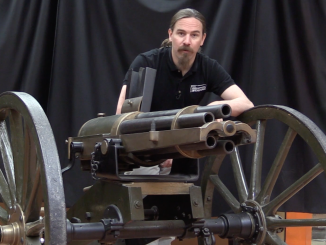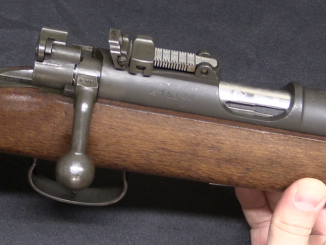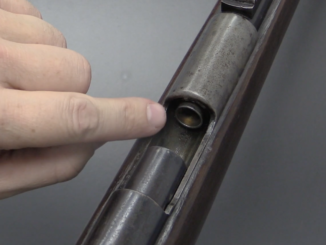Louis Marie Daudeteau was a persistent and prolific arms designer in France in the late 19th century. Born in 1845, he gained substantial military experience in the Franco-Prussian War, and afterwards turned to weapons design. He built a variety of different arms for military consideration, from magazine conversions of the Gras to machine guns, rapid-firing cannons, and self-loading rifles. Ultimately, however, he came closest to military acceptance with his 1891-1896 bolt action rifle.
While the bolt mechanism is similar to that of the Lebel and Berthier, Daudeteau’s rifle used a 5-round fixed magazine fed by stripper clips, had a much simpler disassembly procedure (no need to remove a screw to take the bolt out), and controversially used a 6.5mm cartridge. At the time, there was substantial debate over the effectiveness of such a small bullet (much like there still is today regarding 5.56mm and 7.62mm NATO cartridges). Daudeteau, correctly, saw his round as vastly superior to the 8mm Lebel cartridge because of its flatter shooting, better terminal ballistics, and better penetration.
The French Army rejected his rifle on a technicality, but the French Navy was interested enough to purchase several hundred for extended troop trials in Indochina in 1895/6, and this Series S carbine is one of those trials guns.




“Louis Marie Daudeteau”
http://forums.gunboards.com/archive/index.php/t-112779.html
states that his original name was Louis d’Audeteau, later (when?) changed to Daudeteau. Has anybody explanation of that change? Why it was done?
Ok, I found here:
http://www.littlegun.info/arme%20francaise/artisans%20s%20z/a%20soc%20fr%20armes%20port%20fr.htm
that
Louis d’AUDETEAU (je précise que la particule de son patronyme avait été omise pour transformer la dénomination de ses prototypes en simple “DAUDETEAU” à une époque ou la République, dure, laïque et plutôt sectaire, n’appréciait guère ces évocations d’ancien régime lorsque l’on désirait présenter ses inventions à l’État…!)
I rather don’t understand it and on-line translator it also of little help, but it seems that d’ was somewhat associated with “old regime” (can anybody with better knowledge about France political history in second half of 19th century help?) which in that time got negative sentiment.
Hi Daewoo,
It’s a correct interpretation, particules “De”, “Du”, or “D'” are a clear sign of noblity (litteraly translated => from)
It was rather badly seen after the end of the second empire (1871), it was a period of reconstruction and enhancement of the Republic.
“The hard, secular, and rather sectarian Republic, did not appreciate these evocations of the old regime when it was desired to present its inventions to the State …!)”
i forgot to mention detached particules
“L’Ancien regime” means the old, more or less absolute monarchy, which existed prior to the French Revolution in 1792. The beginning of that era is less clearly defined, but 15th century is often quoted. By that time the Medieval feudal system had been weakened enough that the King was now the practical and undisputed (and not only symbolic) ruler of the country, but the old Feudal lords still possessed significant wealth and privilege, most importantly land. Dautedeau’s ancestors belonged to that landowning aristocracy.
The term is sometimes extended to similar systems in other European countries, most notably Prussia and the Austrian Empire, where large part of the system persisted all the way to WW1.
Daweo:
You have got it right. The “de” prefix, like “von” in German, implies a noble origin, which was, it appears, politically incorrect in the French Republic in the late 19th Century.
It makes sense, as the last monarch, Napoleon III, had led France to disaster against Prussia, so anything which related to monarchy or nobility would not have helped a chap trying to sell a rifle to the Republican government.
Interestingly it is more-or-less inverted situation than happened in Austria-Hungary.
D’Audeteau become Daudeteau to have better chance when marketing his rifles
Mannlicher become von Mannlicher for designing repeating rifles for k.u.k. Armee
This was so, as I alluded to below, because the Imperial Austrian (and Austro-Hungarian) political system was similar to the “ancien regime” in France. Aristocracy was still considered to be “better people” than commoners.
Very good looking rifle for its time of creation (1876-7?). Also the shot is uncommonly powerful considering black powder era. Thanks for showing and thanks to Daweo for additional information (rifle looks quite elegant in its original stock).
In the period when the Daudeteau arms were submitted the French Army had already decided to make a quantum leap to semi auto arms since it was felt that any bolt action would only be an incremental improvement.
“French Army had already decided to make a quantum leap to semi auto arms”
Does anyone have information about cartridges developed in process of getting self-loading rifle?
Here: http://www19.wikipedes.eu/03524718/RifleDeMeunier
there is list:
6×58 Meunier 1897
6×60 ENT, 1900
6.5×60 GORRA 1905
6.5×61 STA. 1910
6.5×55.5 Berthier 1910
7×59 STA. 1912
7×57 Meunier 1912
but data for cartridge other than 7 mm are scarce.
Hi,
6.5×61 STA
http://www.municion.org/6Mm/6_5x61French.htm
6.5×55.5 Berthier
http://www.municion.org/6Mm/6_5x55_8French.htm
7×59 STA
http://www.municion.org/7mm/7x59XplSTA.htm
7×57 Meunier
http://www.municion.org/7mm/7x57Meunier.htm
Unfortunatly, no ballistic and/or powder and pressures data
Without that it is hard to say anything about it, but 7×59 STA seems similar (dimension-wise) to .280 Jeffery cartridge.
In Great Britain similar .276 Enfield was developed, I am wondering: does they exchange information? Or the effect are similar as both were inspired by civilian (hunting/sporting) high-velocity cartridge?
Uruguay adopted this based on a 71 Mauser I have one hopefully you will do a video on that for your readers Shoots well with a 160 gr RN
Here, you can see the 1895 Daudeteau’s clip :
http://www.municion.org/Daudeteau/6_5Sr.htm
St. Chamond,(chechemeu in the local dialect) is some km outside St Etienne. It’s the real heart of France’s armament industry, and birth place of the F1 pilot Alain Prost.Even outside the Town Hall there is a place dedicated to him ! “Feuillow”,(expresion of surprise also in the local dialect) !
“real heart of France’s armament industry”
During Great War France fielded Char Saint Chamond
http://www.tanks-encyclopedia.com/ww1/fr/ww1-char_saint_chamond.php
it is probably single series production tank (or fighting vehicle, if you do not consider it tank) which type (not single vehicle) name is from town.
Saint Chamond was by WW1 standards a tank without question. It predated the Renault FT, which would later become the defining ancestor of all “modern” tanks with its revolving turret with the main armament. Even if the Saint Chamond had been developed later than the FT, but still in the 1910s, it would have been a tank. Only in the 1920s it became the norm to define a tank after the features of the Renault FT.
Regarding French experimental military cartridges from around 1900 readers will find a lot of interesting information in the PDF file at link http://www.quarryhs.co.uk/Emeric2017.pdf
It is written with modern military cartridges in mind, but contains a lot of very interesting historical information. The author, Emeric Daniau, is an engineer at the French armament technology ageny DGA. The website is that of well known (Jane’s ammunition handbook) author Tony Williams
Not realy the place to ask it but would anyone have any idea how far a swiss 7.5 mm military issue cartrige shot from a K31 would penetrate into an earthen berm at 300 metres
According to the Swiss K31 field manual from 1944 at 300 m:
40 cm sand
70 cm arable soil
I read this then forgot to thank you for the information
Daudeteau bolt-actions were sold by Manufrance as “Rival” rifles and carbines in a variety of calibres for big game hunting so Msr Daudeteau had some success